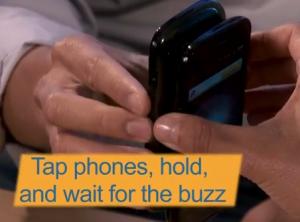PayPal to Introduce NFC P2P Payment Service

PayPal today unveiled its first NFC-based service, demonstrating peer-to-peer payments facilitated by users tapping their Google Nexus S NFC phones together.
The large online payments service, a unit of Web marketplace eBay, plans to introduce the service in late summer, said Laura Chambers, senior director for PayPal Mobile, who demonstrated the service at the MobileBeat 2011 conference in San Francisco.
“But at PayPal, we’ve said all along that consumer behavior won’t change unless we’re able to offer an experience that’s truly better than what’s available today,” said Chambers in a blog post today. “We’ve been looking at NFC technology for a while, and we saw a tremendous opportunity to combine the best of NFC and the best of PayPal.”
As with other PayPal mobile-money transfers, the funds are still sent over the mobile network, with the sender entering his PayPal PIN code to complete the transaction. But instead of opening PayPal’s app and filling out the fields, users would initiate the transfer by entering the P2P request into a PayPal widget, a sort of miniature application that sits on the home screen. They would then tap their phones on the NFC phones of the persons from which they are requesting money.
PayPal, which projects it will handle $3 billion worth of mobile payments in 2011–a forecast it has already increased two times–is planning to make the jump to the physical point of sale. NFC is important to its mobile strategy, but is not the only technology it is investigating. And the NFC P2P service is apparently separate from its POS strategy, which it has yet to reveal.
EBay last week announced a $240 million acquisition of m-payment company Zong, which enables users to buy digital goods and have the purchases billed on their mobile phone bills. That followed two acquisitions in the spring–of mobile advertising and recommendations service Where and mobile-payments startup Fig Card, which uses WiFi technology and USB tokens to enable merchants to accept payments from smartphone users at physical stores. PayPal has also offered P2P transfers on Android phones and the iPhone with technology from Bump, which enables users to shake their phones together to make exchanges. The technology uses both the network connection and accelerometers to pinpoint users.
“This (NFC) is just one of the many ways we’re using different technologies on different devices to change the way people pay and get paid,” Chambers said.
The NFC P2P payment service likely will be available only on the Nexus S phones when launched later this summer, though more Android-based NFC phones are expected later in the year that could support the service. And PayPal could develop software for other mobile operating platforms.
According to a video PayPal released today on the P2P service, a user could request money by tapping a request-money button in the widget on her home screen then entering the amount and tapping a separate request-money button. She would then tap her NFC phone against the NFC phone of the person from which she is requesting money and would wait for the phone to buzz. This confirms the request for money has been transferred.
After what appears to be a second tap, the sender would enter his PayPal PIN, which initiates the money transfer over the mobile network. PayPal would send the recipient an e-mail confirming the transfer to her PayPal account.
PayPal would secure the transaction in part with an “encrypted token,” according to reports, but this token does not refer to the secure element embedded in the Nexus S.












